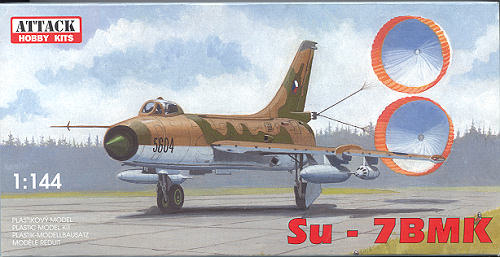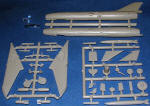
| KIT: | Attack Hobbies 1/144 Su-7BMK |
| KIT #: | 14410 |
| PRICE: | Approximately $6 from http://hobbyshop.cz |
| DECALS: | Five options |
| REVIEWER: | Scott Van Aken |
| NOTES: |

| HISTORY |
The Su-7, given the NATO reporting name 'Fitter-A,' was originally intended as a fighter to counter NATO's F-100 Super Sabre and F-101 Voodoo fighters, in service with the USAF. It was armed with two NR-30 30 mm cannon in the wing roots, with 70 rounds per gun. In keeping with the vogue for unguided rocket armament, early models had provision for an under-fuselage rocket pack, but this was quickly abandoned. The Su-7 entered service in 1958, but in 1959 it was decided, that a basic Soviet fighter would be MiG-21, and a production of Su-7 fighters was canceled after building less than 200 machines. As the Su-7B, the 'Fitter' soon found its metier as a ground-attack fighter-bomber, entering frontline service in 1961. In the Soviet service, its primary purpose became carrying of tactical nuclear weapons.
The Su-7's combat capabilities were limited. With a tiny internal fuel volume of 2,940 l (647 imp gal), its operational radius, even with drop tanks, was poor - seldom more than about 300 km (200 miles), and it had almost no useful range at all with maximum ordnance. Take-off and landing speeds were also very high, requiring long runways. Su-7BKLs had provision for JATO, but this only made logistics even more complicated, so it was rarely used. An additional problem with early models was that the afterburner took six to seven seconds to light, a handicap in combat.
In its favor, the 'Fitter' was very easy to fly, with docile handling characteristics. Its controls were notoriously heavy, but it was forgiving and predictable. The thirsty engine provided exceptional rate of climb and low-level speed. Furthermore, the entire aircraft was extraordinarily tough and robust, easy to service and cheap to operate (except in fuel consumption). Despite its limitations, it was popular with pilots. The Su-7 saw combat service in the Six Day War in 1967, the War of Attrition, and conflicts between India and Pakistan. Although used mostly in the ground attack role, an Indian Air Force Su-7 did shoot down a Pakistani Shenyang F-6 (Chinese copy of the MiG-19) in 1971.
The limitations of the Su-7, particularly in take-off distance, led the Soviets to pursue the swing-wing Su-17, but the Su-7 remained in service through the 1980s. It was exported in the thousands to some Soviet Bloc and Warsaw Pact nations as well as many other air forces. In addition to the USSR, users were: Afghanistan (about 120), Algeria, Czechoslovakia (about 60), Egypt, India (about 160), Iraq, North Korea, Poland (46), South Yemen, and Syria, possibly Bangladesh.
1965 saw the introduction of the Su-7BKL (KL stands for "kolyesa i lyzhi" i.e. wheels and skids, which improved the 'Fitter's' rough field capability with larger tires, provision for rocket-assisted take-off with two SPRD-110 JATO rockets of 29.4 kN (13,300 lbf) thrust, and an unusual set of sprung skid attachments for the main landing gear, spreading the load on a larger surface area once the main wheels sank deeper into the ground. It also added twin braking parachutes, and a new AL-7F1-250 engine.
| THE KIT |
 Molded in a light grey plastic, the detailing is engraved and quite nicely done. Some might think it a bit overdone for this scale, but really, they couldn't do it much lighter and still have it present. Many parts that would normally be several pieces are one-piece in this scale, and that includes wings, tail planes and drop tanks among them. The nose wheel and gear le
Molded in a light grey plastic, the detailing is engraved and quite nicely done. Some might think it a bit overdone for this scale, but really, they couldn't do it much lighter and still have it present. Many parts that would normally be several pieces are one-piece in this scale, and that includes wings, tail planes and drop tanks among them. The nose wheel and gear le g are in one section and some of the gear doors are combined. There is detail in the wheel wells, which is nice. One could replace the gear doors with sheet brass for a more scale thickness. You could also build this gear up as most of the doors will need to be cut prior to use.
g are in one section and some of the gear doors are combined. There is detail in the wheel wells, which is nice. One could replace the gear doors with sheet brass for a more scale thickness. You could also build this gear up as most of the doors will need to be cut prior to use.
I found some sink areas but all were on the back side of things so won't be seen, with one exception. A huge one in one of the drop tanks. Careful placement may make that invisible. The kit includes side panels for the cockpit and an instrument panel with some detail on it. No control stick or rudder pedals so you'll have to make those. Frankly, you won't see much through the very thick but surprisingly clear transparency. Ordnance includes bombs and rocket pods as well as the aforementioned drop tanks. Drop tanks on the centerline, bombs inboard and rocket pods outboard. The instructions show you exactly where on the pylons to fit these, a nice touch.
Instructions are somewhat basic, but more than adequate. You have a parts guide, five construction steps and a painting/decal guide for five aircraft. Humbrol and generic color names are provided. The options are all camouflaged in various ways. You have aircraft from Czechoslovakia, Egypt, Russia, India and Iraq The decals are very nicely done , though the roundels for Egypt and India are out of register. If you have other Su-7 kits you can rob what wasn't used from them. The decals work superbly and you'll like them.
| CONCLUSIONS |
This is yet another really neat kit from Attack Hobbies. They have been making a name for themselves by producing quality 1/144 military aircraft and it is nice to see that they are now including interiors, something missing from their MiG-15/17 kits.
| REFERENCES |
August 2006 My Thanks tohttp://hobbyshop.cz for the review samples. Get yours on-line at the link to the left. If you would like your product reviewed fairly and fairly quickly by asite that has nearly 325,000 visitors a month, please contactme or see other details in the